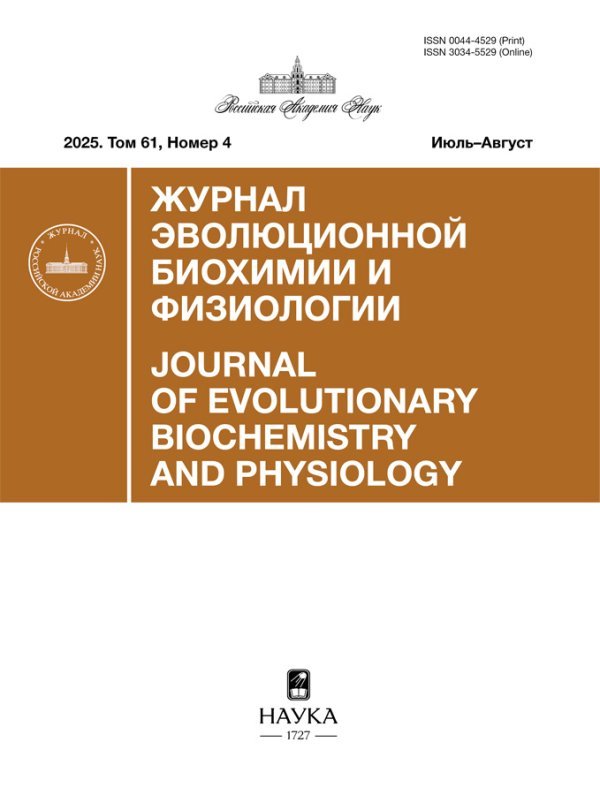Features of carotenoid accumulation in the bivalve Abra segmentum in the Black Sea
- Authors: Borodina A.V.1, Zadorozhny P.A.2
-
Affiliations:
- Institute of Biology of Southern Seas, Russian Academy of Sciences
- Institute of Chemistry FEB RAS, Russian Federation
- Issue: Vol 61, No 1 (2025)
- Pages: 26-31
- Section: EXPERIMENTAL ARTICLES
- URL: https://rjsvd.com/0044-4529/article/view/682103
- DOI: https://doi.org/10.31857/S0044452925010039
- EDN: https://elibrary.ru/CGWOQT
- ID: 682103
Cite item
Abstract
The bivalve mollusk Abra segmentum is widespread on the Crimean coast in sandy-silty soils. Its adaptive capabilities to changes in salinity, temperature and hypoxia are interesting from the point of view of the participation of carotenoids in them. The aim of the work was to study the carotenoids of this mollusk in the coastal zone at a depth of 0-0.2 m. In the period from February to April, the level of total carotenoids in the mollusk tissues fluctuated from 1.7 ± 0.2 mg / 100 g dry matter to 0.4 ± 0.1 mg / 100 g dry matter. The study of the carotenoid composition of A. segmentum mollusks taken in coastal zones showed the presence of 11 carotenoids, including isomers and esters of 3 carotenoids. Among the dominant carotenoids are: β-carotene (15.2%), diadinoxanthin (7.3%), fucoxanthin (5.8%), trans-halocynthiaxanthin (9.3%), cis-halocynthiaxanthin (7.6%), trans-pectenol A (13.6%), cis-pectenol A (7.9%). A. segmentum accumulated both plant carotenoids and subjected some to metabolic transformation: fucoxanthin→ fucoxanthinol→ halocynthiaxanthin (cis- trans); diatoxanthin→ pectenol A (cis- trans-). The possible role of A. segmentum carotenoids in death of fish due to hypoxia discussed.
Keywords
Full Text
About the authors
A. V. Borodina
Institute of Biology of Southern Seas, Russian Academy of Sciences
Author for correspondence.
Email: borodinaav@ibss-ras.ru
Russian Federation, Sevastopol
P. A. Zadorozhny
Institute of Chemistry FEB RAS, Russian Federation
Email: borodinaav@ibss-ras.ru
Russian Federation, Vladivostok
References
- Latypov YY (2015) The Bivalve Mollusc Abra ovata: Role in Succession of Soft Bottom Communities on Newly Flooded Area of the Caspian Sea. American Journal of Climate Change 4: 239–247. https://doi.org/10.4236/ajcc.2015.43019
- Maire O, Duchêne JC, Rosenberg R, de Mendonça JB Jr, Grémare A (2006) Effects of food availability on sediment reworking in Abra ovata and A. nitida. Marine Ecology Progress Series 319: 135–153. https://doi.org/10.3354/meps319135
- Анистратенко ВВ, Халиман ИА, Анистратенко ОЮ (2011) Моллюски Азовского моря. Киев: Наукова думка.
- Revkov NK, Boltachova NA (2021) Benthic fauna of the south-western part of the Sea of Azov: transformation of macrozoobenthos biocoenosis at the beginning of the XXI century. Ekosistemy. 26: 51–66. (In Russ). https://doi.org/10.37279/2414-4738-2021-26-51-66
- Goodwin TW (1984) The biochemistry of the carotenoids: animals. London; New York: Chapman and Hall.
- Карнаухов ВН (1988) Биологические функции каротиноидов. Москва: Наука.
- Karnaukhov VN, Milovidova NY, Kargopolova IN (1977) On a role of carotenoids in tolerance of sea molluscs to environment pollution. Comp Biochem Physiol A Comp Physiol 56 (2): 189–199. https://doi.org/10.1016/0300-9629(77)90183-9
- Borodina AV, Soldatov AA (2019) The Effect of Anoxia on the Content and Composition of Carotenoids in the Tissues of the Bivalve Invader Anadara kagoshimensis (Tokunaga, 1906). Russ J Biol Invasions 10(4): 307–314. https://doi.org/10.1134/S2075111719040027
- Mandelli F, Miranda VS, Rodrigues E, Mercadante AZ (2012) Identification of carotenoids with high antioxidant capacity produced by extremophile microorganisms. World J Microbiol Biotechnol 4: 1781–1790. https://doi.org/10.1007/s11274-011-0993-y
- Koldaev VM, Kropotov AV (2022) Carotenoids in practical medicine. Pacific Medical Journal 1: 65–71. https://doi.org/10.34215/1609-1175-2022-1-65-71
- Soldatov AA, Gostyukhina OL, Borodina AV, Golovina IV (2017) Glutathione antioxidant complex and carotenoid composition in tissues of the bivalve mollusk Anadara kagoshimensis (Tokunaga, 1906). J Evol Biochem Physiol 53(4): 289–297. https://doi.org/10.1134/S0022093017040056
- Киселева МИ (1981) Бентос рыхлых грунтов Черного моря. Киев: Наукова думка. [Kiseleva MI (1981) Benthos of loose soils of the Black Sea. Kyiv: Naukova Dumka. (In Russ)]. https://repository.marine-research.ru/handle/299011/8133
- Borodina A, Zadorozhny P (2021) Ecological features of the accumulation of carotenoids in the Black Sea molluscs. IOP Conference Series: Earth and Environmental Science 937: 022077. https://doi.org/10.1088/1755-1315/937/2/022077
- Coesel S, Oborník M, Varela J, Falciatore A, Bowler C (2008) Evolutionary origins and functions of the carotenoid biosynthetic pathway in marine diatoms. PLoS One 3(8): e2896. https://doi.org/10.1371/journal.pone.0002896
- Barkhatov YV, Zykov VV, Khromechek EB, Prokopkin IG, Rogozin DY (2021) Measuring alloxanthin as a proxy approach in a study of trophic relationships between zooplankton and cryptophyte algae in Lake Shira. J Sib Fed Univ Biol 14(2): 154–167. https://doi.org/10.17516/1997-1389-0345
- Partali V, Tangen K, Liaaen-Jensen S (1989) Carotenoids in food chain studies — III. Resorption and metabolic transformation of carotenoids in Mytilus edulis (Edible mussel). Comp Biochem Physiol Part B: Comp Biochem 92 (2): 239–246. https://doi.org/10.1016/0305-0491(89)90272-1
- Maoka T (2011) Carotenoids in Marine Animals. Mar Drugs 9: 278–293. https://doi.org/10.3390/md9020278
- Borodina AV (2022) Features of Carotenoid Profile in Black Sea Bivalve Mollusks. J Evol Biochem Physiol 58 (4): 943–954. https://doi.org/10.1134/S0022093022040019
- Polyakov NE, Leshina TV (2006) Certain aspects of the reactivity of carotenoids. Redox processes and complexation. Russ Chem Rev 75 (12): 1049–1064. https://doi.org/10.1070/RC2006v075n12ABEH003640
Supplementary files













